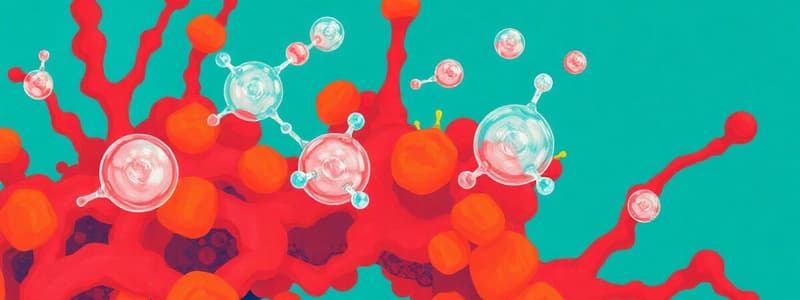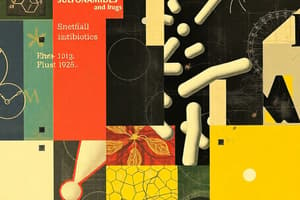Podcast
Questions and Answers
What do sulphonamides structurally resemble?
What do sulphonamides structurally resemble?
- Dihydropteroate
- Amino acids
- Folic acid
- PABA (correct)
What process do sulphonamides inhibit in bacteria?
What process do sulphonamides inhibit in bacteria?
- Nucleotide synthesis
- DNA replication
- Folic acid synthesis (correct)
- Protein metabolism
How do sulphonamides function in microbial cells?
How do sulphonamides function in microbial cells?
- By competing with PABA (correct)
- By degrading folic acid
- By promoting folic acid production
- By enhancing PABA absorption
What is the primary molecular target of sulphonamides?
What is the primary molecular target of sulphonamides?
What is the outcome of sulphonamides inhibiting folic acid synthesis?
What is the outcome of sulphonamides inhibiting folic acid synthesis?
What is the state of tubercle bacilli when they survive for years in tissues?
What is the state of tubercle bacilli when they survive for years in tissues?
What factor helps to restrain the multiplication of tubercle bacilli in the host?
What factor helps to restrain the multiplication of tubercle bacilli in the host?
Why are persisting tubercle bacilli resistant to anti-tuberculous drugs?
Why are persisting tubercle bacilli resistant to anti-tuberculous drugs?
How long can tubercle bacilli survive in tissues?
How long can tubercle bacilli survive in tissues?
What happens to tubercle bacilli due to their metabolic inactivity?
What happens to tubercle bacilli due to their metabolic inactivity?
What is a primary cause of drug resistance in antimicrobial chemotherapy?
What is a primary cause of drug resistance in antimicrobial chemotherapy?
Which of the following scenarios could lead to drug resistance?
Which of the following scenarios could lead to drug resistance?
Prolonged treatment with antibiotics can result in what complication?
Prolonged treatment with antibiotics can result in what complication?
What practice can contribute to the development of drug resistance in antimicrobial therapy?
What practice can contribute to the development of drug resistance in antimicrobial therapy?
What is not a reason for the development of drug resistance?
What is not a reason for the development of drug resistance?
What do plasmids code for in relation to antibiotics?
What do plasmids code for in relation to antibiotics?
Which antibiotic structure is targeted by the enzyme produced from plasmids?
Which antibiotic structure is targeted by the enzyme produced from plasmids?
What is the function of beta-lactamase in bacteria?
What is the function of beta-lactamase in bacteria?
Which compounds are known to have their efficacy reduced by beta-lactamase?
Which compounds are known to have their efficacy reduced by beta-lactamase?
What type of genetic element is responsible for the production of beta-lactamase?
What type of genetic element is responsible for the production of beta-lactamase?
What effect do tetracyclines have on the developing fetus and infants?
What effect do tetracyclines have on the developing fetus and infants?
During which stage should tetracyclines be avoided?
During which stage should tetracyclines be avoided?
Which of the following is a consequence of tetracycline use in pregnant individuals?
Which of the following is a consequence of tetracycline use in pregnant individuals?
Why should tetracyclines be used with caution in infants?
Why should tetracyclines be used with caution in infants?
What is a major characteristic of tetracycline-related dental effects in children?
What is a major characteristic of tetracycline-related dental effects in children?
What is the recommended preventive measure before dental procedures for patients with Congenital or Rheumatic heart disease?
What is the recommended preventive measure before dental procedures for patients with Congenital or Rheumatic heart disease?
In which situations is chemoprophylaxis indicated for surgery?
In which situations is chemoprophylaxis indicated for surgery?
What type of heart disease requires a single dose of Amoxicillin before dental procedures?
What type of heart disease requires a single dose of Amoxicillin before dental procedures?
Which of the following surgeries does NOT require chemoprophylaxis?
Which of the following surgeries does NOT require chemoprophylaxis?
Why is Amoxicillin prescribed before dental procedures for certain patients?
Why is Amoxicillin prescribed before dental procedures for certain patients?
Flashcards
What are sulphonamides?
What are sulphonamides?
Sulphonamides are drugs that have a similar structure to PABA (para-aminobenzoic acid).
What is PABA?
What is PABA?
PABA is a crucial ingredient for bacteria to produce folic acid, which is essential for their growth and survival.
How do sulphonamides work?
How do sulphonamides work?
Because sulphonamides resemble PABA, they can bind to the enzyme that uses PABA to create folic acid, effectively blocking its production.
What is the consequence of sulphonamide action?
What is the consequence of sulphonamide action?
Signup and view all the flashcards
What are sulphonamides?
What are sulphonamides?
Signup and view all the flashcards
Tubercle Bacilli Dormancy
Tubercle Bacilli Dormancy
Signup and view all the flashcards
Persistence of Tubercle Bacilli
Persistence of Tubercle Bacilli
Signup and view all the flashcards
Metabolic Inactivity of Dormant Bacilli
Metabolic Inactivity of Dormant Bacilli
Signup and view all the flashcards
Drug Resistance in Dormancy
Drug Resistance in Dormancy
Signup and view all the flashcards
Metabolic Inactivity and Drug Resistance
Metabolic Inactivity and Drug Resistance
Signup and view all the flashcards
Plasmid
Plasmid
Signup and view all the flashcards
Beta-lactamase
Beta-lactamase
Signup and view all the flashcards
Beta-lactam ring
Beta-lactam ring
Signup and view all the flashcards
Plasmid transfer
Plasmid transfer
Signup and view all the flashcards
Antibiotic resistance
Antibiotic resistance
Signup and view all the flashcards
Tetracycline Side Effect
Tetracycline Side Effect
Signup and view all the flashcards
Tetracyclines and Pregnancy
Tetracyclines and Pregnancy
Signup and view all the flashcards
Tetracyclines and Bone/Tooth Development
Tetracyclines and Bone/Tooth Development
Signup and view all the flashcards
Inadequate Dosage
Inadequate Dosage
Signup and view all the flashcards
Prolonged Treatment
Prolonged Treatment
Signup and view all the flashcards
Antibiotic Abuse
Antibiotic Abuse
Signup and view all the flashcards
Susceptibility Testing
Susceptibility Testing
Signup and view all the flashcards
Pyogenes
Pyogenes
Signup and view all the flashcards
Amoxicillin for dental procedures
Amoxicillin for dental procedures
Signup and view all the flashcards
Endocarditis
Endocarditis
Signup and view all the flashcards
Chemoprophylaxis
Chemoprophylaxis
Signup and view all the flashcards
Surgeries needing Chemoprophylaxis
Surgeries needing Chemoprophylaxis
Signup and view all the flashcards
Study Notes
Antimicrobial Chemotherapy
- Antimicrobial drugs are either naturally produced or synthetically prepared.
- Naturally produced drugs (antibiotics) inhibit the growth of other microorganisms.
- Some examples of antibiotics are penicillin (produced by Penicillium fungi) and streptomycin (produced by Streptomyces bacteria)
- Synthetic antimicrobial drugs are also known as chemotherapeutics.
- Antibacterial drugs are categorized into two classes.
- Bactericidal drugs: cause rapid, irreversible killing of microorganisms. Examples include penicillin, vancomycin, and cephalosporins. These drugs inhibit cell wall formation.
- Bacteriostatic drugs: cause reversible inhibition of microbial growth. Examples include tetracyclines, chloramphenicol, and erythromycin. These drugs inhibit protein synthesis.
Range of Action of Antimicrobial Drugs
- Antibiotics are categorized based on their activity spectrum.
- Drugs active against Gram-positive organisms (e.g., penicillin, erythromycin; limited spectrum)
- Drugs active against Gram-negative organisms (e.g., nalidixic acid, polymyxin; limited spectrum)
- Drugs active against both Gram-positive and Gram-negative organisms (e.g., ampicillin, tetracyclines, chloramphenicol; broad spectrum)
Therapeutic Index (TI) of Antimicrobial Drugs
- Therapeutic index (TI) is the ratio between the blood concentration of the drug at which it causes a lethal effect to the concentration at which it has its therapeutic effect.
- High TI = Safer drug.
- If the TI is low, careful dosage monitoring is required.
Mechanism of Action of Antimicrobial Drugs
- Ideal antimicrobial agents exhibit selective toxicity, targeting microorganisms without harming host cells.
- The mechanism of action of an antimicrobial drug depends on the inhibition of a metabolic process or structure present in the microbe, but not in the host cell.
- Inhibition of cell wall synthesis (e.g., penicillin).
- Inhibition of cytoplasmic membrane function (e.g., polymyxins).
- Inhibition of protein synthesis (e.g., chloramphenicol, tetracycline).
- Inhibition of nucleic acid synthesis (e.g., quinolones).
- Competitive inhibition (e.g., sulphonamides).
Mechanism of Resistance to Antimicrobial Agents
- Microorganisms develop resistance to antimicrobial agents through various mechanisms.
- Production of enzymes that inactivate the antimicrobial agent (e.g., beta-lactamase).
- Modification of the target site of the drug (e.g., modification of LPS in gram-negative bacteria).
- Alteration of metabolic pathways to bypass drug inhibition.
- Acquisition of new mechanisms for drug transport to reduce uptake of drug (in gram-negative bacteria).
- Changes to the antibiotic receptor site.
Origin of Resistance to Antimicrobial Agents
- (A) Non-genetic resistance:
- Metabolic inactivity of certain microorganisms.
- Loss of target structure of certain microorganisms.
- (B) Genetic resistance mechanisms:
- Chromosomal drug-resistance: Mutations in genes that control microbial susceptibility.
- Extra-chromosomal drug-resistance: Resistance carried by extra-chromosomal elements like plasmids or transposons.
Complications of Antimicrobial Chemotherapy
- (1) Development of Drug Resistance: inadequate dosage, prolonged use.
- (2) Drug Toxicity:
- Selective Toxicity: damage to specific tissues (e.g. 8th cranial nerve)
- Overdosage may cause toxic reactions
- (3) Superinfection: Suppression of normal flora leads to an overgrowth of drug-resistant pathogens.
Hypersensitivity reactions
- Drugs may act as haptens
- May lead to tissue damage
- Can cause reactions including: Anaphylactic shock, urticaria, skin rash, diarrhea, vomiting.
Chemoprophylaxis
- Chemoprophylaxis is the use of antimicrobial agents to prevent rather than cure infectious diseases.
Combined Use of Antibiotics
- Used in treatment of serious infections or tuberculosis.
- Rationale is to avoid resistance development, reduce toxicity, and maximize therapeutic benefits.
Antibiotic Policies
- Abuse of antibiotics should be avoided to prevent the emergence of antibiotic resistance, reduce costs, and prevent toxicity.
Studying That Suits You
Use AI to generate personalized quizzes and flashcards to suit your learning preferences.




